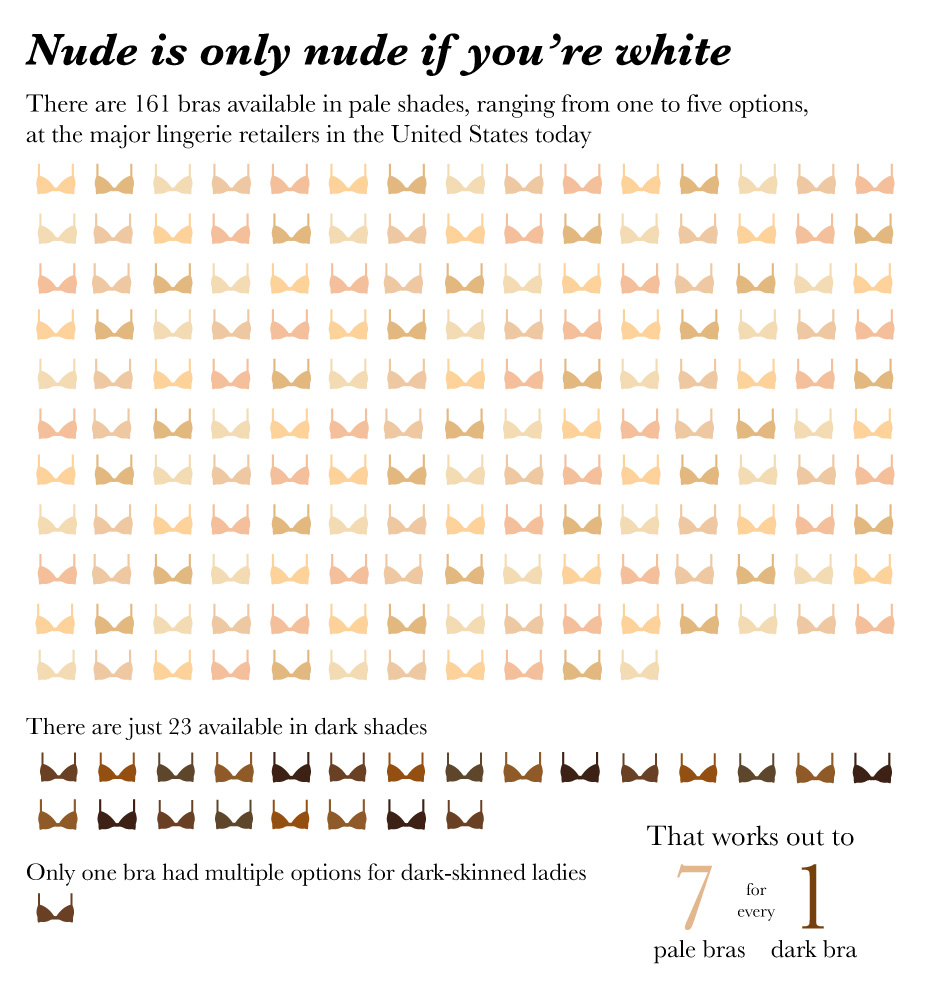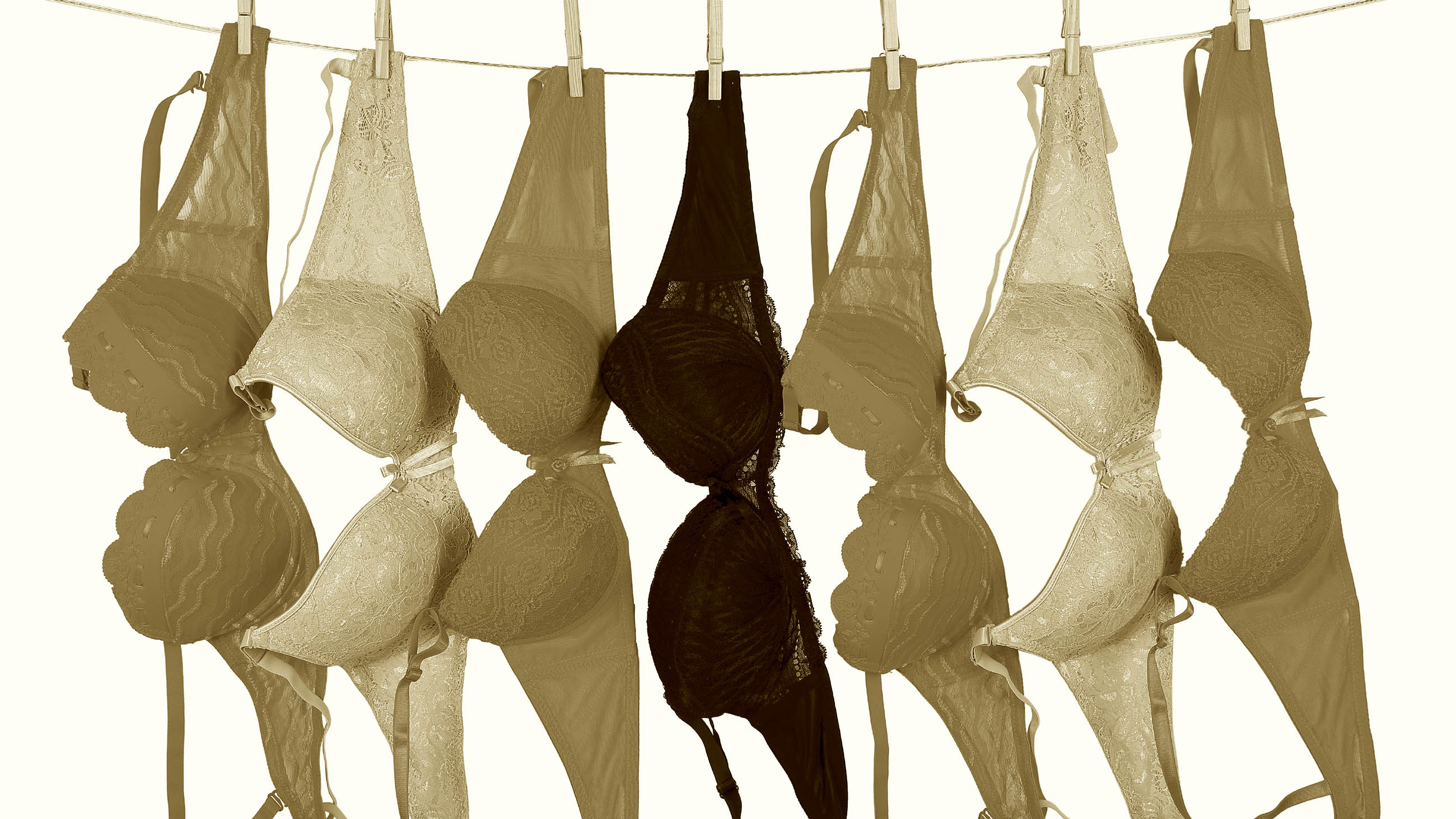The Naked Bias of Bra Color
In a technical sense, so-called “nude” bras are designed to match a woman’s mix of epidermal eumelanin and pheomelanin, polymers that, along with a variety of other factors, nudge human skin color along the dark-light spectrum. By extension, the bras are supposed to offer a bit of invisibility under light-colored clothing, and while they aren’t perfect, if you’re a pale-skinned woman like me, they do get the job done.
But if you’re black in America, those nude bras aren’t really nude at all — and the options are alarmingly limited.
Until the lingerie company Nubian Skin launched its line of dark skin tone bras in 2014, it was hard for many black women to find an appropriately skin-toned bra. “My nude isn’t the nude I see in shops,” the founder of that company wrote at the time of its launch. “Despite the reality that women of color have the same needs as all women when it comes to lingerie and hosiery … the industry simply doesn’t cater to us.”
Two years later, for the most part, it still doesn’t.
Victoria’s Secret, Maidenform, and the various Hanes brands (among them Playtex and Wonderbra) hold the lion’s share of the lingerie market in the United States. That means when your average woman goes bra shopping, odds are she’s looking at a bra made by one of those brands.
About 88 percent of those bras are available in at least one pale skin tone. Nearly 29 percent are available in multiple pale shades. Only 12.6 percent come in a dark skin tone. I know this because I looked at every single bra that these brands sell online. Of 183 bras, only one bra came in multiple dark skin tones. It was the Lilyette by Bali Plunge Into Comfort Keyhole Minimizer Bra, which I suppose I have to applaud for its diversity — if not for its name.
Here’s my breakdown:

It’s possible that some of these bras aren’t meant to blend in. Maybe they’re meant to be worn under thick, dark clothing or at trendy music festivals. So let’s be generous and say that only the 88 percent of bras that came in pale skin tones (161 bras out of the 183 I checked) were intended to be worn discreetly. There were 23 bras that came in dark skin tones, which amounts to just 14 percent of the available stock.
This includes the 10 Victoria’s Secret bras that came in what they termed “Dark Iron Crochet Lace.” Since that lacy bra wasn’t really a solid color at all, it was virtually useless as a nude style bra. So really it’s more like 13 bras, total, in dark skin tones. Which isn’t to say that these companies skimp on color variety. Even the standard Playtex brand averaged over four color options per bra. Victoria’s Secret had almost 12 colors on average.
It’s difficult to say why these companies are ignoring the 13 percent of American women who are black, though it likely starts at the top. Only three of the 260 shows at New York Fashion Week 2015, after all, were developed by black designers. Just 12 of the 470 members of the Council of Fashion Designers of America — that’s 2.6 percent — are black.
Most elite fashion designers aren’t working on something as simple as bras, but perhaps a lack of black fashion executives translates into a poor understanding of what “nude” actually means. Maybe the scientific nuances of the human epidermis escape them, or maybe they’ve failed to grasp the way in which light interacts with both skin and fabric to produce truly “nude” bras.
Either way, they should study up. We’re failing black women in America in so many ways — at least give them their bras.
Sara Chodosh is a graduate of the University of Pennsylvania, where she received a B.A. in neurobiology and philosophy of science. She is currently pursuing a masters degree in the Science, Health and Environmental Reporting Program (SHERP) at New York University. This article is provided by Scienceline, a project of SHERP.











Comments are automatically closed one year after article publication. Archived comments are below.
Love this post. I have to say that I thought it was hard to find decent bras in my size but then you put a desired skin toned color into the mix, it’s a whole other issue. Thank you for bringing more awareness to the problem
I thought just getting a pretty DDD was an issue. This really out weighs me completely. I never really thought of it. But the African American women do need a discreet way to wear a bra. They have so many occasions like us and clothes as we do that call for this option. All of these big bra makers are missing the mark with the money train. Hopefully this happens soon, can we work on the pretty DDD bras too after that.
Wow. Insightful
This is a great post! I don’t have a problem finding a nude bra that’s close to my particular shade of pasty, but my best friend brought this issue up when we were still in middle school and your article just highlights how little things have changed. It’s a shame that we’ve recognized diversity and embraced it in so many ways, but there are still a lot of foundational suppositions that do not reflect those recognitions. This is just one of the many ways major companies still fail to recognize the beauty of all women. Thank you for sharing!
I am an ex-dancer and suprsingly very tanned for a white girl. I used to have this very same issue in college believe it or not, finding “nude” and “skin coloured leotards or costumes for a dance piece so we all looked the “same” which we evidently did not. However, the bias in the dance world was even worse when it came to my mixed-race friends looking for “nude” because “nude” does not exist.
Recently one of my friends shared this video to Facebook.
A breakthrough. Finally. Hopefully.
https://www.facebook.com/PopSugarCelebrity/videos/10154239195084824/
Great post <3
Great article and insight! It’s not just about the bra color but inclusion. We as people of African descent are still being overlooked, discarded and unrecognized unless it’s in degrading, demeaning or sexual situations. We’ve come far….but WE as a race have a very, very long way to go!
good article, ?
I loved this article. Even though you talk about one issue, it press on so many more subjects that are important. So much more than a shade of the bra.
This reminds me of how dependent we are for our perceived needs, those needs created by others, often times corporations, who pretty much see the world thru white male eyes, when the only real solution is to take the world by the reins and create a reality that fits. A survey like this communicates one more niche to be aware of.
Try finding a nude strapless bra for a milk chocolate coloured skin girl in a size DD+ in the UK it’s virtually impossible. Why ? No idea because we exist but the shops don’t like to cater to us . Maybe they think we don’t wear bras and have stereotypes.
And in London we have such diversity even though I am of African decent, I’m sure many Asians can’t find a nude shade for them either ( more likely than me ) but probably a very hard job too.
Loved this article!
Finding the right color matters. But finding the right size is utmost important.
Good information and very genuine concern of “nude” color..after reading this every entity has a different nude color..thats an amazing thought…
I have long moved on from trying to find nude bras. I am a very dark-skinned Black woman who absolutely loves her skin tone. So, my “nude” is beautiful, but apparently we have much to do in terms of seeing vendors and designers think the same. Another area where I find the comedy of “nude” related to fashion is with shoes. Nude pumps have been all the rage for the past few years because they elongate the legs of a woman. I’m not a tall woman, so yes, I would love that! However, has anyone ever seen shoes in any myriad shade of brown that would be fitting for a Black woman in all the colors and shades that we come in? Pretty sure you haven’t but if that’s not the case, let me know!
Thanks for talking about this, Sara. I thought it was just me! Looking forward to where the continued dialogue may take us next!
I think this is just another facet of a wider problem with the lingerie industry. They design for those who are small in height, small boned, and who are at most a B cup. Which is about 5% of the population, tops. I shop at Bravissimo (I’m in the UK) and they do offer a wide range of bright colours, which is something if you wear anything other than white tops.
I’ve noticed fewer uniforms require a white top these days than used to be the case.
Huh… :)
It is INSANITY, to me, that there is not a broadly used color scheme. It is INSANITY, to me, that the needs for THE ENTIRE DARKER SKINNED COMMUNITY continue to not be met. It is TOO much to ask, that if there is a GREEN colored bra, that there, INSTEAD be a dark brown colored bra, (or as well)? It’s nuts that this is not the norm! On a scale of issues, while this may not be the top, it certainly IS an issue.
This entire article is what’s insane. Every single issue has to have a black/white color theme. The White people are put down and the Black people put us down for the same reason they complain about, skin color Well to set everyone straight. I am not white, this screen is white there’s only a couple shade of white, bright white, off white, and white. Now depending on the time of the year my light blush, light tan, skin can go to a dark tan brown or ligher tan, but never have I ever been white, only albinoes have white skin. I am white if I am, them Blacks are Black, not African Americans. So we want to be called European-Americans. And if bra color is such an issue, start you a business and create your own bras. And stop all this drama…it’s to much. There are so many other things that need fixing. Here’s a solution don’t were a bra and that solves one problem in the world. OMG…One problem marked off that big list.
As a black woman, nude bras being anything but discrete has been something I just accepted. It makes me think of how many other issues I subconsciously compromise on without a word. Change doesn’t happen until we demand it. We vote with our dollars and what we give light to. Perhaps this article will be the beginning of a new standard for nude…for ALL women.
Spot on!
yes, that might be true but, you must think about every bra express a women’s personality wise. Meanwhile, a bra can tell a lot about a women, just like what they wear in the community.
That’s very informative. It’s is really hard to get fitting bras then again to come think of colour
I completely agree! Like it isn’t already hard enough to find a bra that fits and is comfortable, why make it harder to find one the right colour!?
Interesting as man to read because these are insidious problems I would have never even known of. Thanks for shedding a light on this issue.
it shouldn’t be a issue for women to fine a nice color bra, but it is a issue to fine the right size bra.